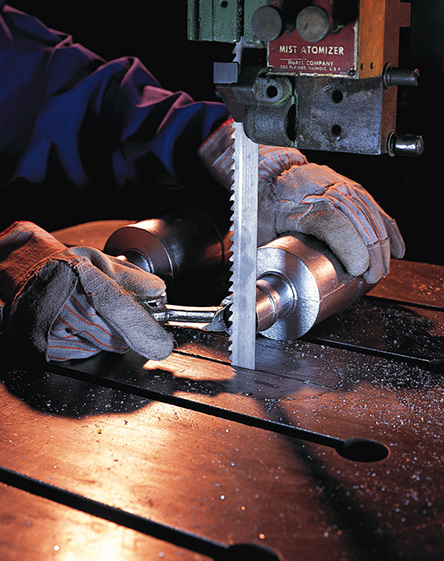Band Saw Blades
We carry the highest quality band saw blades ensuring you have the most durable blades for the job.

Picking The Right Blade
When looking for the right band saw blade, you may use the following points as a checklist.
1. Band Length
The band saw determines the band dimensions. The operator’s manual for your machine(s) will also list the appropriate blade lengths.
2. Band Width
If you have a horizontal machine, then the manufacturer determines the width of the band. A vertical band saw has higher variations of the band’s width also. But, the general rule is the wider the band saw blade, the higher its stability. For contour cuts, for example, the smallest radius of cuts is the limiting factor for the band’s width. The ability to cut curves is also determined by the width of the band. Wider bands are better for straight cuts in thicker material. Narrower bands are then better for contour cuts. A general rule to follow is the blade’s width should then be less than the radius of the curve. Manufacturers provide a more accurate guide. Contact us and we can help you choose the ideal width for your application.
3. Cutting edge material
There are four main groups of cutting edge materials:
Carbon steel
Hardness: approx. 850 HV
Tempering resistance: approx. 200°C
High-speed steel
Hardness: approx. 1000 HV
Tempering resistance: approx. 600°C
Carbide
Hardness: approx. 1600 HV
Tempering resistance: approx. 800°C
4. Teeth Per Inch
The number of teeth per inch will result in a difference in the cut made. More teeth per inch will result in a finer cut edge. Less teeth per inch will leave a rougher cut edge.
5. Types of Bandsaw Blade Teeth
Bandsaw blades come with various types of teeth. Tooth shape depends on the material being cut, the speed of the cut, the importance of cut cleanliness and other factors.
Regular Tooth
Regular tooth bandsaw blades are the most common as they are used for general purpose cutting in common materials. They are typically used for cutting thinner amounts of wood, metal and plastics. The teeth are evenly spaced, stright faced and have a deep gullet.
Hook Tooth
Bandsaw blades with hooked teeth make fast coarse cuts in materials like plastics, woods and metals. Hook teeth have a deep gullet and widely spaced larger teeth when compared to a regular tooth blade.
Skip Tooth
Skip Bandsaw blades are used primarily for woodworking applications and cutting of softer materials. The skip teeth have a sharp angle, shallow gullet and are widely spaced.
So what band saw blade are you looking for?
Band Saw Blade Types
Band Saw Blades for Metal
Blades are bi-metal and are also used for basic cutting applications. Blades combine non-ferrous metals and also mild steel. Non-ferrous metals include brass, copper and aluminum.
Other top-end band saw blades have more universal usage, cutting carbon steel and also other small to medium-sized profiles (50%).
Band Saw Blade for Wood
Blades are carbon steel with silicone for flexibility, reliability, and performance. They are also induction heat-treated to provide maximum hardness and wear resistance.
Band Saw Blade for Meat & Fish
High-grade carbon strip steel that easily cut through fresh and frozen meats; including bone.


For Band Saw Blades and More, Check Out Our Store.
Check out our online store, or locate us on our contact page here.
